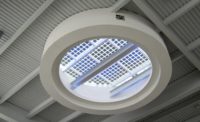In the late 1960s, the Baruffi family operated one of the largest interior plastering companies in southern New Jersey. But as drywall was gaining popularity, they could foresee that their interior plastering business would soon be a thing of the past. Beginning in the early seventies, their company began to examine other opportunities to replace their core business.
One of the replacements was a new concept that would revolutionize the plastering industry. It was called EIFS. The EIFS business helped stabilize their company but one of the brothers, Dominick Baruffi, knew they must keep looking for other opportunities to expand their business. He soon found the answer: the company would start building prefabricated curtain wall panels for commercial projects and in 1982 Jersey Panel was formed. Prefabbed steel stud framing and EIFS would be the business of the future.
Background
Prefabrication can be defined as the assembling of components offsite in a manufacturing process and then, transporting to the jobsite for installation. The use of the prefabrication concept in construction is not new. The Ancient Romans used a cement mixture which was poured into molds to make prefabricated parts used in building aqueducts, tunnels, and other structures.
Today, prefabrication is a growing part of the construction industry as owners seek to reduce the time of construction, improve performance, and lower the overall cost of the project. This building practice can be found in many segments of the construction industry such as electrical, civil works, housing, and even ship building.
In the late 1970s and throughout the ’80s, the prefabrication of curtain walls was a relatively new concept. A curtain wall is an outer system attached to the outside of the non-load-bearing structural frame which is designed to protect the building against the elements while providing an architecturally pleasing appearance. A variety of claddings can be used in curtain walls. Some of these are brick, tile, stone, metal, glass and EIFS.
EIFS was an ideal choice since it is lightweight and offers many design options. So, in the late ’70s, metal stud companies such as Inryco and EIFS manufacturers like Dryvit, Senergy, and Sto as well as panel contractors began to promote the concept to the architects and owners. Dryvit took the lead in the development of panelization contractors as a number of their customers got involved in the business. Soon panel contractors sprung up across the country and the prefabrication panel business using EIFS, as well as other claddings, began to grow. At the peak of business in the twentieth century, as many as fifty companies were building prefabricated EIFS panels across the country.
Most of the early fabricators came from the plaster or drywall trades. Take Bill Bell, a drywall contractor from Lexington, Kentucky. He saw the potential and in the late seventies formed a panel company called Panel Tech, which today is part of the Kentucky based group called Grayhawk Inc. In Dallas, Baker-Triangle, a plaster and drywall company, did its first panel job in the mid-’70s. These two companies along with Jersey Panel and others are still prefabricating curtain wall panels. Many of the original features and benefits of the prefab concept are still present today but like all industries, over time significate improvements have been made.
The Advantages of Panels
One of the things that makes panels so appealing to the construction industry is the advantage it provides over in-place construction. Construction time is greatly reduced as panels can be built while the site work is being done and the structure is being erected. This means that the owners can occupy the building sooner thus saving money. The panels are lightweight, which lowers the load bearing requirements for the footings and foundations of the structure. Since the panels are built inside there are minimal weather delays. Once the panels are in place on the structure, the building is completed weeks earlier than an on-site installed cladding.
Panels arrive at the jobsite ready to install. In an urban setting where there may be a limited staging area and access to the structure, this can be a major benefit. The manpower needed to install a panel is significantly less than for on-site work, there is no need for scaffolding as the panels are installed by a crane and attached by a crew on the inside of the structure.
Another advantage of panel construction is the wide range of finish options. The curtain wall panel business of the late twentieth century was focused mostly around the EIFS concept which provided a wide variety of texture and color options. These design options were also very popular as shapes, reveals, and dimensions could be added at a fraction of the cost of stone or other materials. But other claddings such as thin brick and cut stone were redesigning and became available to make them more compatible with prefabrication.
The Business Boom and Bust
Throughout the ’80s and into the 1990s the business grew. After all, what owner could resist the advantages that panels offered? Atlantic City and Las Vegas were booming with panel work as a large number of new casinos were built with curtain wall panels. But casinos weren’t the only places where panels were being utilized as high-rise condos, hotels, and office buildings were also utilizing the panel concept.
By the end of the 1980s, there were two types of prefabricating curtain wall contractors. One was the project contractor. In this case the contractor would build panels on a job-to-job basis and would either build them on the jobsite or rent a warehouse for the duration of the project. The other was a company that was committed to the production of panels as a manufacturer and had a dedicated facility for the business.
However, in both cases the construction industry continued to treat the panel process no different than in-place construction. To be successful with panels, a good coordination of the trades is necessary and, unfortunately at times, this was not the case. As a result, there were job failures due to the lack of oversite or improper coordination of the process. Some of these problems were the logistics as panels were damaged in transit, in storage, or during installation. Additionally, complications occurred as panel dimensions didn’t properly line up with the structure, window openings didn’t fit the windows or weren’t properly sealed, and the panel-to-panel sealant joints were not correctly installed.
These building complications created skepticism and concerns from owners and General Contractors causing them to lose interest in the panel business. As a result, there were fewer and fewer jobs. The industry thinned out and by the mid-nineties only a hand full of contractors were still using prefabricated panels. The demand for panels declined and the prefabrication of the curtain wall panel almost vanished. If the panel business was to continue, the industry had to understand that the overall problem was understanding that building with panels is different than building in-place. Construction as a manufacturing process needed to be coordinated with the overall building of the project. As Baruffi with Jersey Panel told me, “There is a methodology to building with panels; it’s a process.”
Rebounding
Throughout the remainder of the 20th century and into the 21st century, the prefabrication of curtain walls continued in a few markets, the northeast being the most active. As the recession of 2008 hit, the panel business slowed like all construction. However, the recession gave everyone a chance to think about how to improve the construction process and the prefabrication of curtain walls was no different. In 2011 as the economy began to rebound, different challenges faced the construction industry. A large part of the labor pool and skilled labor force was gone and new technology had been developed which could be utilized in construction.
The companies that stayed in the prefabricated curtain wall business along with a few newcomers developed a different plan. These companies accepted the challenges and formed a new platform for the business. This meant that the prefabricated curtain wall business would completely change. The paradigm would shift. New technologies would be embraced, new partnerships would develop, advanced concepts would be adopted, methodologies would change, and there would be a shift from a construction mindset to one of a manufacturing process. With this new approach to the business the future for prefabricated curtain walls appears to be bright. W&C










Report Abusive Comment